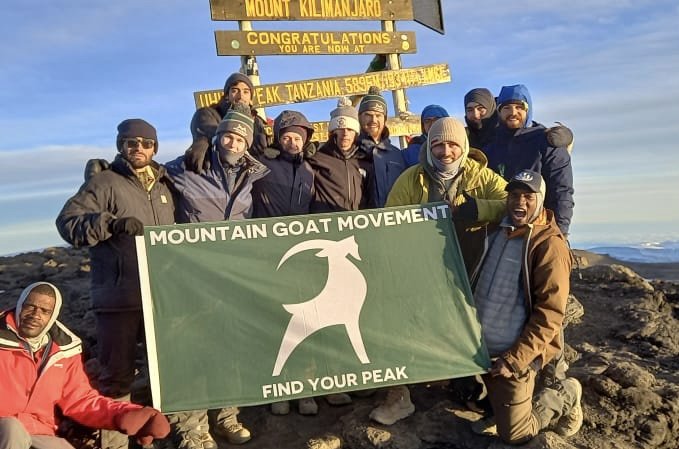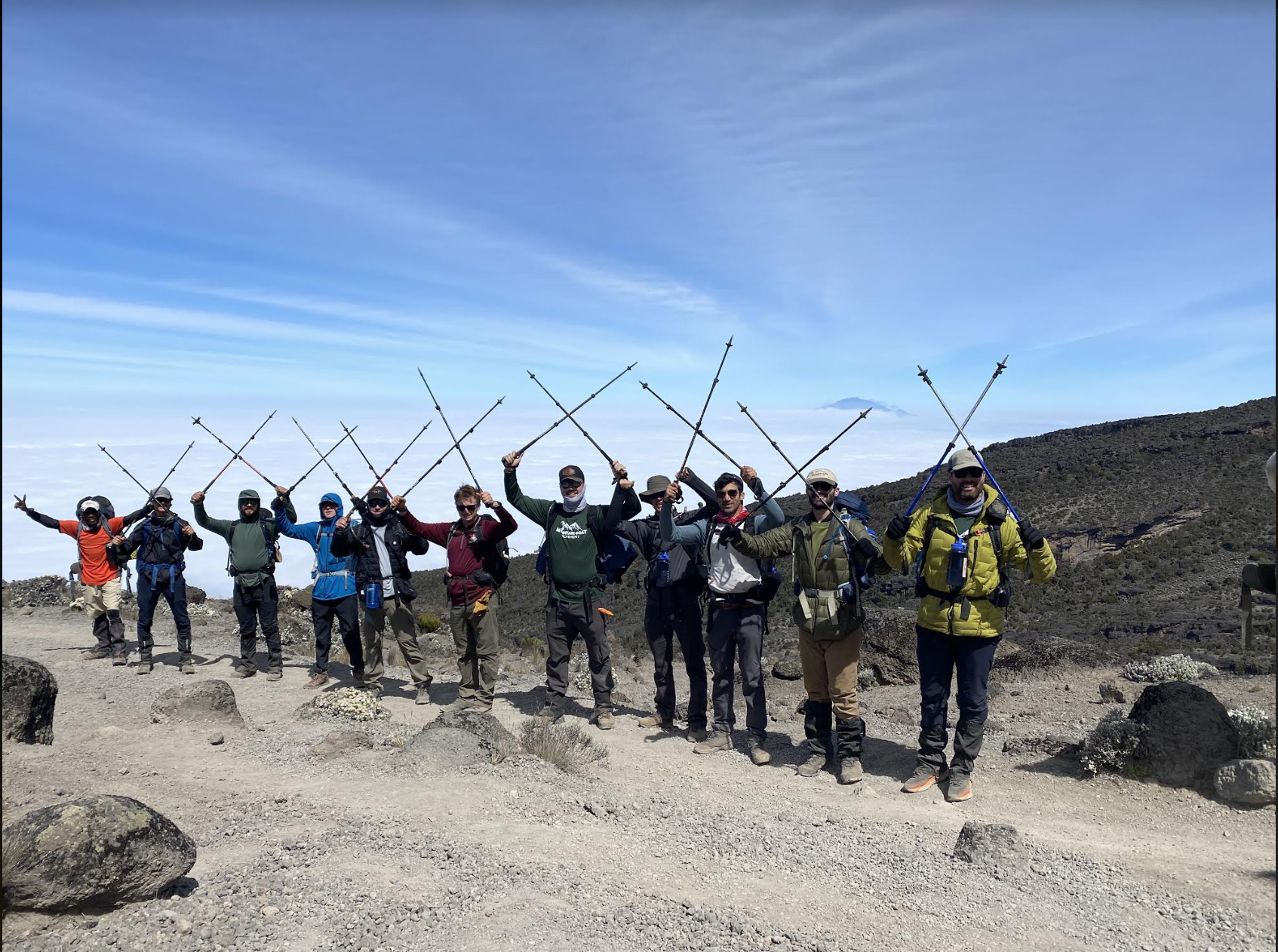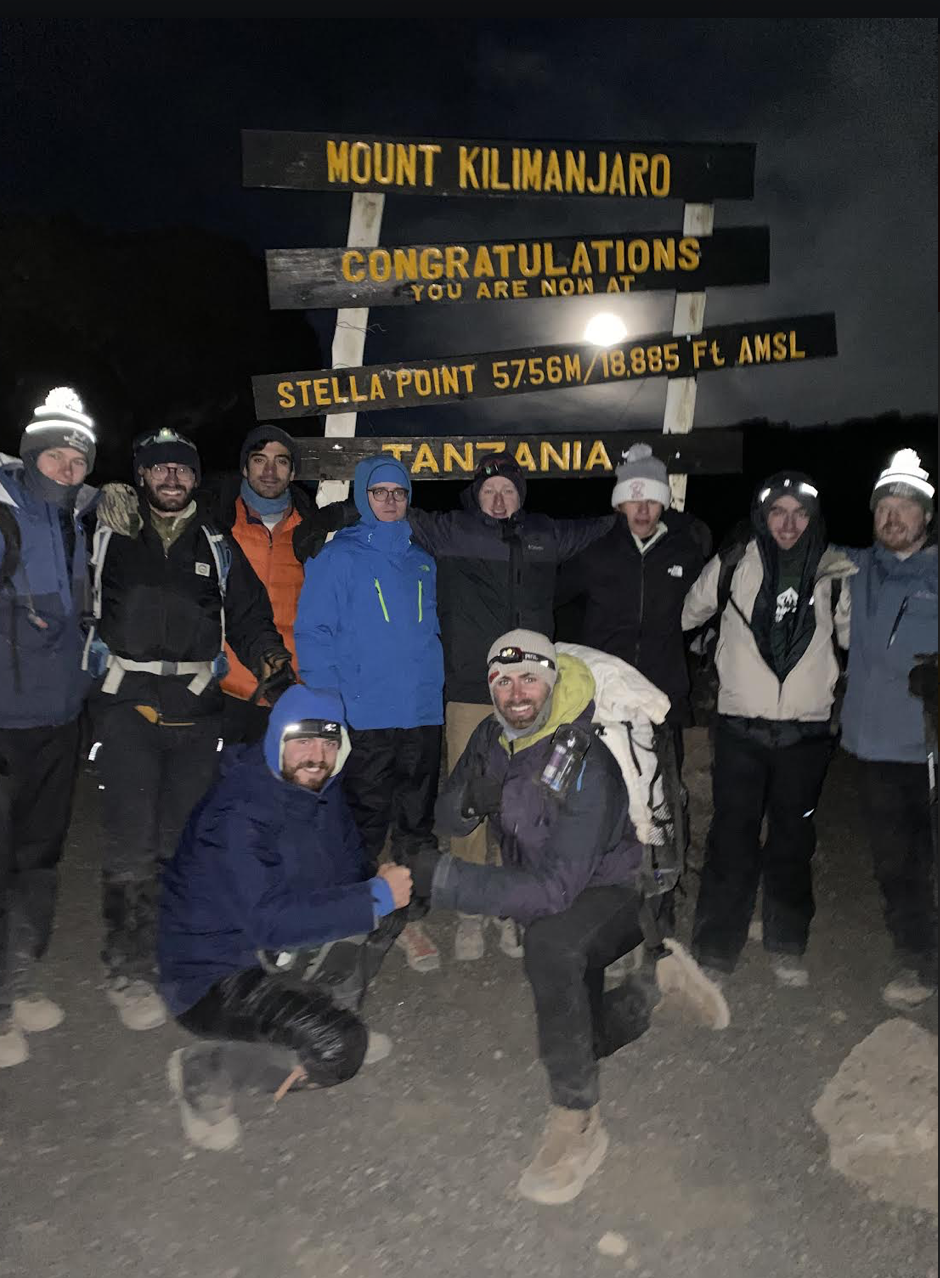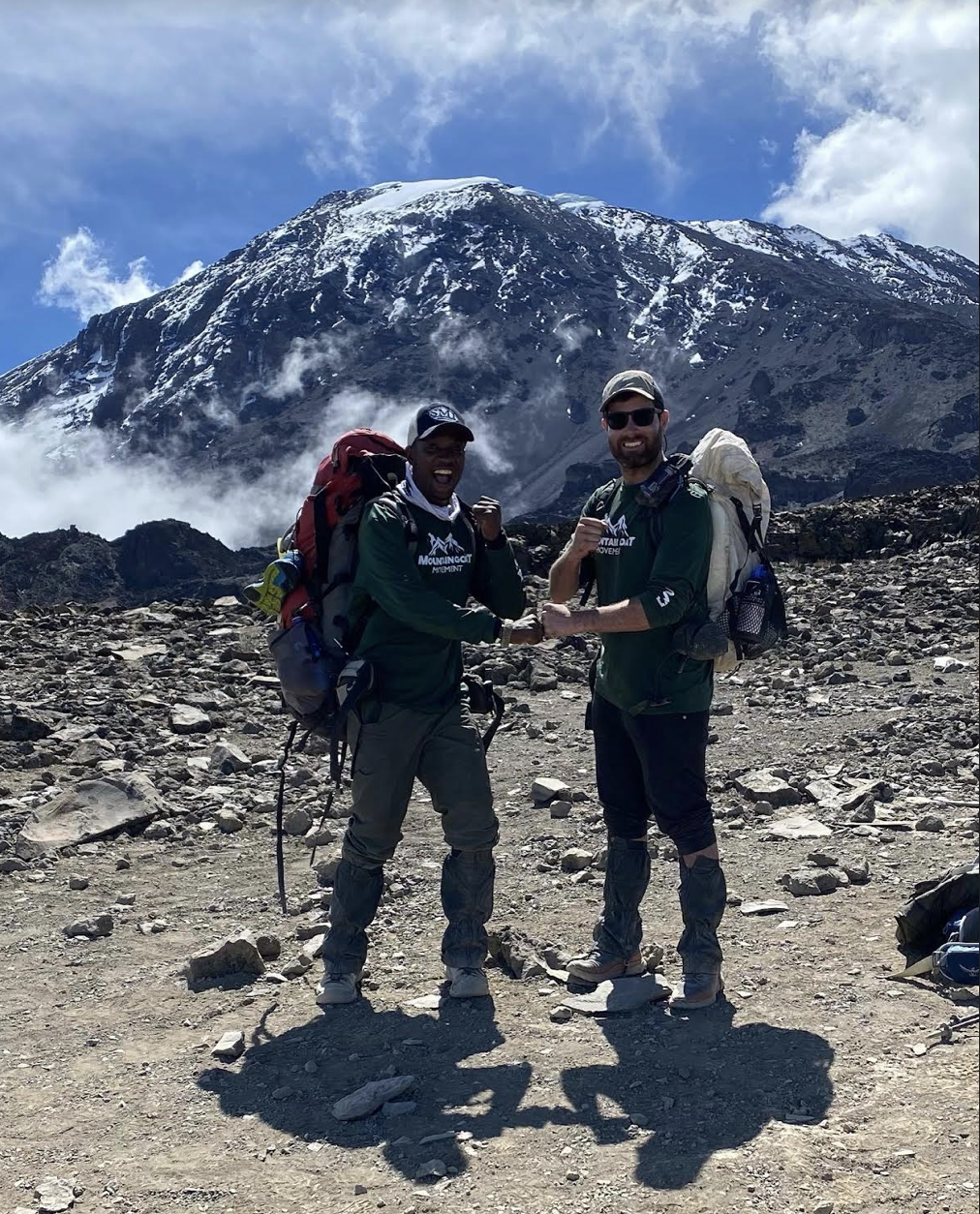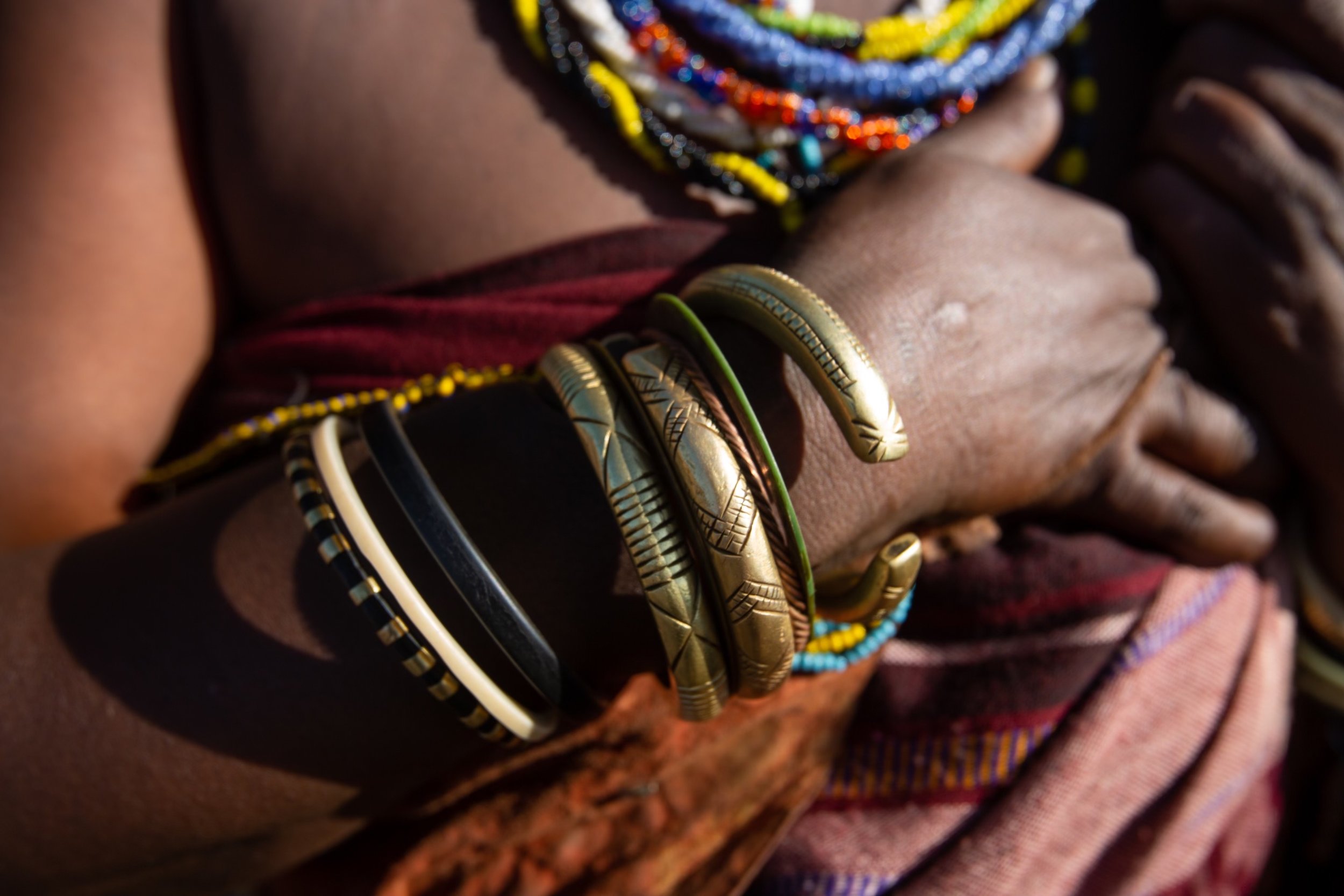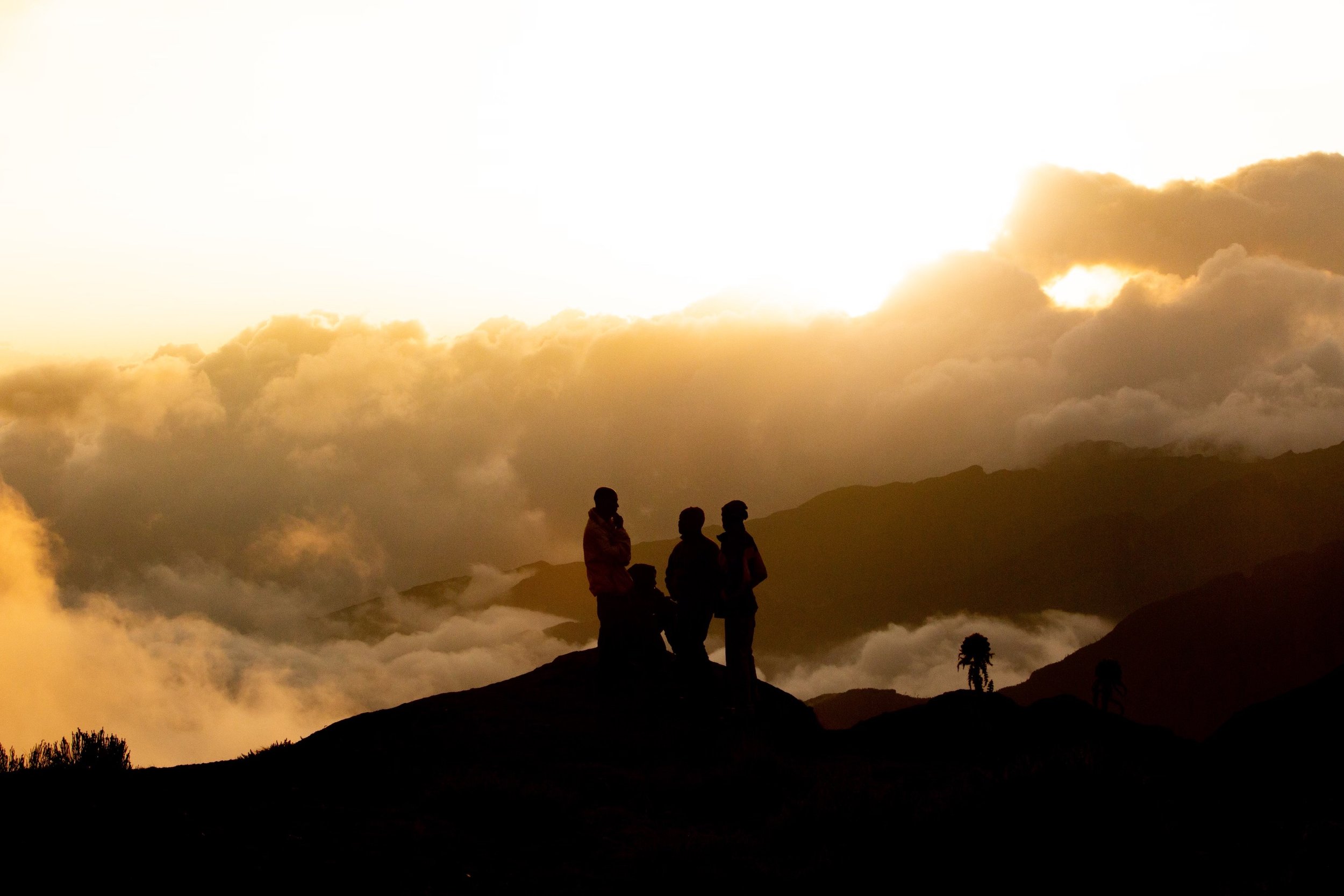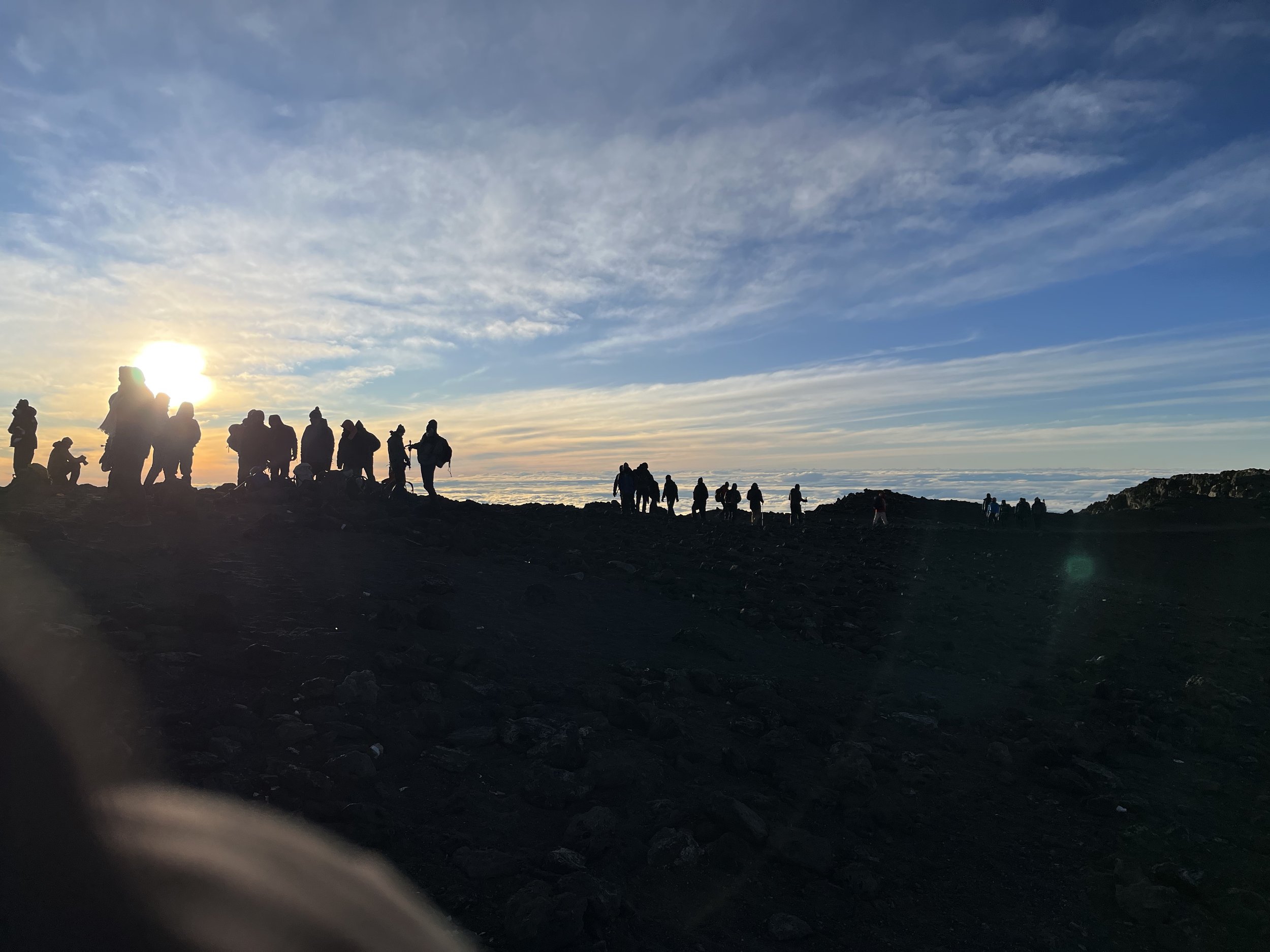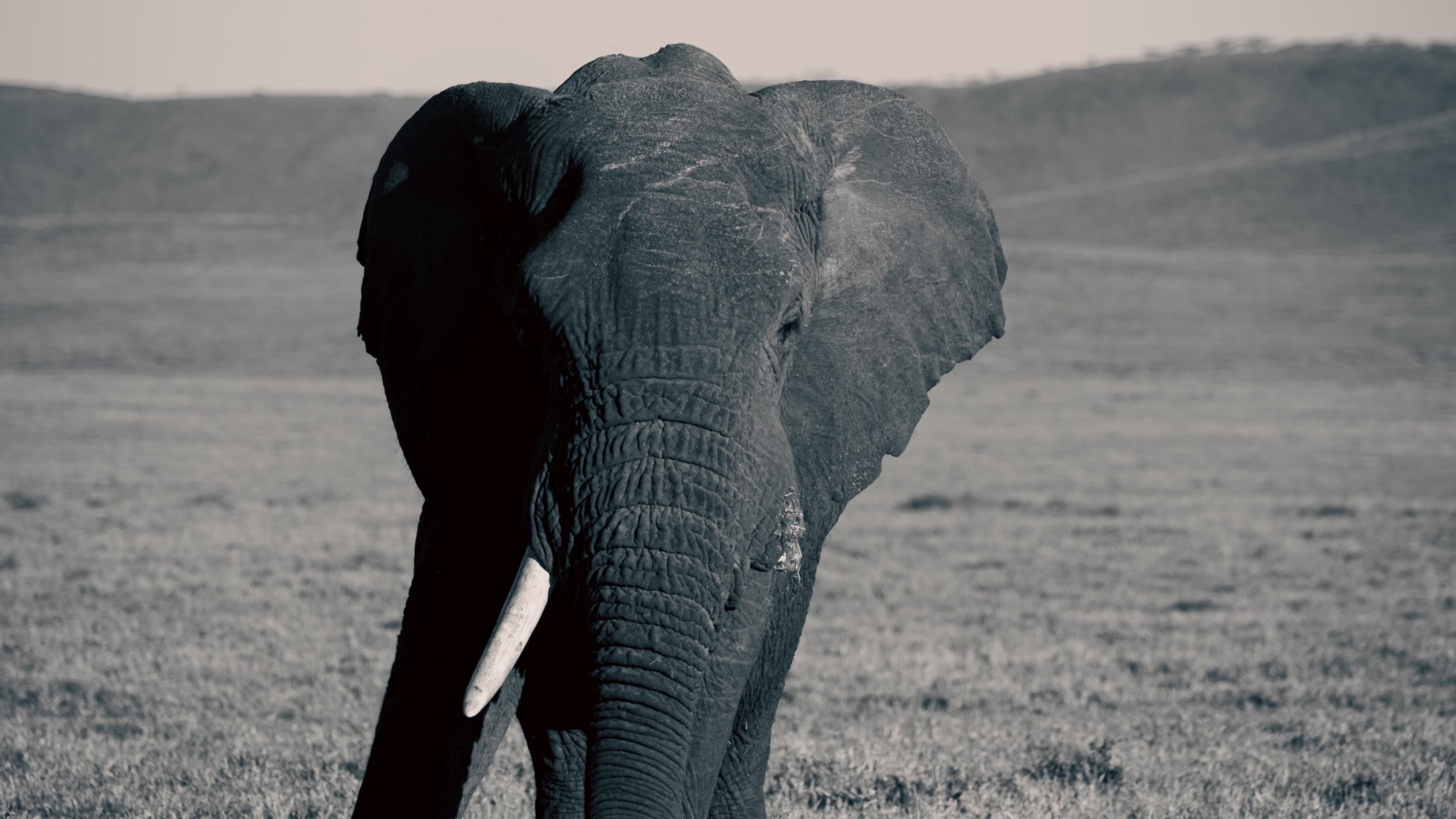Kilimanjaro, in Tanzania, is the tallest mountain in Africa at 19,341 feet. Alongside a team of seasoned porters, Mr. Greg Morrissey will guide a group on the Umbwe Route (the route with the highest success rate of summiting on a 7-Day trek) to the summit of Kilimanjaro. The trek itself is an appropriate amount of time for participants to acclimate to the altitude. The trek begins in the jungle and ends in the alpine – participants can experience four seasons over the course of a week. Local students from Tanzania will also join us on this trek to forge an impactful cultural experience — the uniting and teamwork of students from all over the world! Moreover, we will complete a meaningful conversation project which will be determined by April 2024 — depending on the needs of our friends in Tanzania. This is a remarkable experience, and it will change your life!
Check out our article on climbing Mt. Kilimanjaro for more information.
-
The Trek: Kilimanjaro is a life highlight. Trek through all four seasons over 7 days. Reach the top of Africa. See the sunrise over Africa on your summit day. See the curvature of the Earth. Experience a spiritual journey that will forever change your life.
The Cultural Exchange: Two (2) High School / University students from Tanzania, and local to Kilimanjaro will be on our expedition team. After all, what is more important than sharing life-giving experiences with new friends of various backgrounds and interests!
The Conservation Project: Adventures are more meaningful when we can learn from the places that we explore (and hopefully leave it as a better place for others!). An impactful project with learning objectives that coincide with the United Nations Sustainable Development Goals will be chosen by April 15, 2024. The expedition team, consisting of explorers and educators, will work with students to design and execute an meaningful conservation project.
Strong Hearts, Strong Minds!
-
June 23 - July 3, 2024
Day 1: Depart from the United States for Kilimanjaro Airport in Tanzania.
Day 2: Group arrives in Amsterdam on various flights and will fly together to Tanzania arriving at Kilimanjaro International Airport at 8:45 PM. A short walk off the airplane across the tarmac brings us inside the terminal where we purchase visas (if you didn’t get one in advance), get our luggage, and clear customs. Drivers will be waiting to pick us up and bring us to our hotel in Moshi, Tanzania. This drive takes approximately 45 minutes.
Day 3: Today is a rest day. We will use it to pack our gear and meet the team. You can leave some of your gear (clothing for the latter portions of the trip) at the hotel if you wish. Meals included: Breakfast, Lunch, Dinner
Day 4: Climb Day 1. Umbwe Gate to Umbwe Camp, 1600m to 2900m: After a 7 AM breakfast at the hotel, we will load our gear into a vehicle and drive to the park gate. The porters take our duffle bags here. Our route of choice is the Umbwe as it offers excellent acclimatization over the course of 7 days. The Umbwe is generally less traveled and offers the best scenery on the mountain.The hiking today is mostly underneath a jungle canopy, where it is sometimes possible to see black and white colobus monkeys and blue monkeys in the trees above us. If there has been a recent rainstorm, the trail can be muddy, and many people wear lightweight gaiters to keep some of the mud off their legs. The hike normally takes 5-8 hours.
Breakfasts, lunches, and dinners will be provided each day during the climb.
Day 5: Hike to Camp 2, Umbwe Campe to Barranco Camp, 2940m - 3970m: After breakfast we pack our duffels for the porters and leave camp at 8AM. The scenery opens up and we get some of our first glimpses of Kilimanjaro. If it was muddy yesterday it usually becomes less
muddy as we leave the jungle canopy shortly after beginning today’s hike. Today’s hike normally takes 3-5 hours.
Day 6: Barranco Camp Acclimatization Day’: After breakfast we pack our duffels for the porters and leave camp at 9 AM. Giant ridges and valleys dominate the landscape on either side of us. On a clear day the Heim Glacier on the upper reaches of Kilimanjaro fills out our view above. We also hike through the spectacular giant senecio trees. Our high point today is Lava Tower at 4630m, 15,190’. On a clear day, views in front of us looking at the Western Breach Wall provide spectacular scenery. In the distance Kilimanjaro's satellite peak Mt. Meru is seen nearby. From camp, Kilimanjaro’s Western Breach Wall dominates the scenery above us on a clear day. Today’s hike normally takes 1- 3 hours. Afternoon teatime and rest will precede dinner. We will sleep at Barranco Camp again.
Day 7: Hike to Camp 3, Karanga Camp, at 3930m, 12,893’: After breakfast we pack our duffels and leave camp at 9 AM. Today our route takes us over the Barranco Wall. It has a couple spots that require using your hands and feet but no previous rock climbing skills are required. We help with a spot from below and above to surmount the small section about 10-15 feet. Beyond Barranco Wall our route traverses down into valleys and up on ridges. The upper reaches of Kilimanjaro including the summit are to our left. After 3-4 hours of hiking we descend into Karanga Valley. This lush valley is the last of its kind before ascending to higher ground leading to the summit. Ascending the other side of Karanga Valley takes 45 minutes - 1.5 hours. Our camp is at the top of this hill. Afternoon teatime and rest will precede dinner.
Day 8: Hike to Camp 4, Barafu Camp at 4600m, 15,100’: After breakfast we pack our duffels and leave camp at 9 AM. Our route ascends above vegetation zones into the subalpine region. The landscape is dominated by outcroppings of volcanic rock and on a clear day we can see the jungle canopy below. A slow steady pace brings us to our camp in 3-5 hours. Upon arrival we get settled in camp and prepare for our summit day the following morning. We have an early dinner before sunset so we can get in our tents in preparation for an early wakeup call in the morning.
Day 9: Summit Day, 4600m/15,100’ - 5895m/19,340’ - 3048m/10,000’: Our exact wake up time is conditions-dependent. It is usually sometime between 10:30 PM and 1:00 AM. We'll rise for a light breakfast of hot drinks and biscuits before beginning our ascent.
What clothing we wear and what we carry in our packs is dependent on the temperature but all our warm clothing will come with us. A local staff of assistants will accompany you on your climb. With headlamps on we will pick our way over a reasonably worn route that switchbacks over the firm volcanic dirt in between larger rock outcroppings. If the weather is clear this night will reveal an awesome blanket of stars above. How many are visible depends on the moon's brightness.
Our pace will be rhythmical, slow and steady as we integrate high altitude breathing and walking techniques. We take breaks at regular intervals approximately every 1 – 1.5 hours. As the sun rises over the African plains below we find ourselves high on Kilimanjaro with the crater rim visible above. We adjust clothing as necessary for the weather that day. The route is usually dirt all the way to the crater rim but sometimes snow can still linger below the rim if there has been a recent storm. Crampons and ice axes have never been necessary for this climb though. We reach the crater rim at Stella Point at 5739m/18,828’. From here it is 1 – 1.5 hours of traversing around the crater rim to the high point called Uhuru Peak at 5895m/19,340’. The climb to the summit can take anywhere from 5-9 hours.
Our descent brings us back to high camp in usually about half the time it took us to ascend. After rest and offloading some of our equipment back to the duffel bags we continue our descent to lower elevation where recovery will be quicker. The descent to Mweka Camp at 3048m/10,000’ takes 2-4 hours. As we drop in elevation the temperature gets milder and the increased oxygen adds an extra boost of energy. We take breaks along the way offering a good chance to stay hydrated. It is always worth an occasional look behind us to admire where we just came from.
Day 10: Descent to the Mweka gate. We wake in the morning for breakfast at a reasonable hour. After packing our gear we descend back down into thicker vegetation. If there has been recent rain in the jungles the terrain can sometimes be muddy. The descent takes 3-4 hours. Once at the gate, we will dance and sing with our remarkable team of porters. Afterwards our vehicle picks us up for the drive back to our hotel, which takes less than one hour. An afternoon lunch is followed by time to rest by the pool, take a walk into the business area of Moshi, and relax. Breakfast and lunch are included. For dinner we usually eat at the hotel or a nearby restaurant.
Day 11 (if needed): The morning will be spent by the pool relaxing and grabbing any final souvenirs before departing for the airport for the return to the United States, or heading for safari. Breakfast included. If you stay at the hotel, buffet-style lunch and dinner can be purchased for $8-10.
-
I.Guide Information
II. Medical + Immunization Information
I.Guide Information
In addition to the primary guides listed below, we also have a team of porters who are responsible for carrying the bulk of gear: tents, cooking supplies, expedition bags (the items you don’t use on a daily basis), and even portable toilets!
Mr. Greg Morrissey is the founder of Mountain Goat Movement. He is an adventure guide, Wilderness First Responder, and storyteller. He has guided big mountain treks all over the world, including Kilimanjaro. For the last 10 years, Greg has guided hundreds of people on outdoor excursions all over the world from as far as South America and as local as the Kittatinny Range in NJ. In 2017, Greg received awards and guest speaking opportunities from the American Alpine Club and North Face for his work with young people. In 2018, Mr. Morrissey earned membership with the venerated Explorers Club, and the Next Generation of Explorers. Moreover, he serves in advisory roles with the American Alpine Club and London’s Scientific and Exploration Society. In 2020, Greg Morrissey supported expedition logistics for his mentor, Vanessa O’Brien, who became the first woman, alongside astronaut Kathy Sullivan, to dive to the deepest part of the Ocean: the Challenger Deep. Some personal projects include surfing the longest wave in the world, completing an unsupported cycling trip from Canada to Mexico in 30 days, completing the Adirondacks’ Great Range Traverse in under 20 hours, walking across Ireland, and next: climbing the highest peak in all 50 states and the the 7 summits– all while raising funds for students. To date, he has raised nearly $100,000 which directly enables low-income students to participate in outdoor adventures.
Mr. Yesse Lema is the Head Chief Guide and Porter. Yesse has led groups to the summit over 500 times. With our route, he has earned a success rate of over 90%. In 2020, Yesse was named Guide of the Year on Kilimanjaro. Yesse and his accomplished team of porters will offer unwavering assistance as you attempt to reach the roof of Africa!
II. Medical + Immunization Information
All participants will need clearance from their primary care provider stating that they are healthy enough to trek at high altitudes. This form will be sent via email to participants.
Below is a list of immunization shots for East Africa. Consult with your Primary Care Doctor regarding this list. You may also find more information through the CDC.
The phone number is (404) 332-4559 or visit their web site at www.cdc.gov.
COVID-19: This is currently either 1 shot if you get the Johnson & Johnson product, or two shots given one month apart if you get the Moderna or Pfizer vaccine.
Hepatitis A: This used to consist of a Gamma Globulin shot that was good for three months. There is now a vaccine called Havrix that is good for ten years. It consists of one shot and a booster given six to twelve months later.
Hepatitis B: All health care workers in the United States are vaccinated for Hepatitis B. The guides get it in case they sometimes have to give first aid to someone in a foreign country. It is becoming more common for the general population to get vaccinated for Hepatitis B. Consult your physician for their advice.
Malaria: There are a couple different medicines in pill form to choose from. The most common are Lariam (mefloquine) taken once a week beginning before departure and continuing 4 weeks after returning home, and Melarone taken daily beginning a couple days before departure and ending a couple days after returning home. Consult your physician for their recommendations.
Typhoid: This can either be two shots given four weeks apart or a live virus consisting of four pills taken once every day.
Yellow Fever: This consists of one shot to be taken at least ten days before departure. The shot is good for ten years after which a booster is needed. The Tanzanian government requires documentation of your Yellow Fever vaccination to enter the country if you are traveling from a Yellow Fever zone such as a layover in Kenya.
Others: Make sure you are currently on diphtheria, polio, and tetanus and ask your doctor about influenza and H1N1.
-
Note: Tents are provided. If you do not wish to purchase items like sleeping bags, sleeping pads, etc then these items can be rented while in Tanzania at our partner hotel. Rates for these items can be found below under “II. Rental Options for Gear”.
I.Packing List
II. Rental Options for Gear
UPPER BODY LAYERS:
TREKKING SHIRT– Long sleeve button down quick drying material. Ex Officio, Patagonia, Royal Robbins SHORT SLEEVE TECH SHIRT– Wool or synthetic. Icebreaker, Marmot, Patagonia
BASE LAYER THERMAL TOP– Comfortable fitting, not snug. Wool or synthetic. Patagonia, Point6
MID LAYER TOP– Fit over your base layer. Wool or fleece. Patagonia, Point6
SWEATER / SOFTSHELL JACKET– Hooded wool, Scholler fabric, or fleece. Icebreaker, Marmot, Patagonia LIGHTWEIGHT DOWN SWEATER OR PUFFY JACKET– Patagonia Nano Puff or similar
WATERPROOF/BREATHABLE JACKET– Gore-Tex or similar fabric. Marmot Speedlight, Patagonia DOWN JACKET– Thick & roomy to fit over all above layers. Feathered Friends Icefall, Mountain Hardwear Nilas, Patagonia Grade VII
LOWER BODY LAYERS:
SHORT UNDERWEAR– Athletic wool or synthetic. Icebreaker, Ex Officio, Patagonia
SHORTS– Comfortable fit, quick dry. Patagonia Baggies are a longtime favorite or buy convertible pants TREKKING PANTS– Comfortable fit. Consider convertible pants that zip into shorts
BASE LAYER THERMAL BOTTOM– Same materials as Base Layer Thermal Top
WATERPROOF/BREATHABLE PANTS– Complete size zips. Same materials as jacket HEAD
SUN HAT OR BALL CAP– Any lightweight hat works.
BUFF OR FACEMASK– for windy/cold days, and to protect against transmissible pathogens and diseases WARM CAP– Wool or synthetic. It should fit underneath a climbing helmet
HANDS:
INSULATED SHELL GLOVES– Warm & not snug fit. Black Diamond Guide, Outdoor Research Alti MID WEIGHT GLOVES– For warmer conditions. Black Diamond Kingpin, Mountain Hardwear Torsion
FOOTWEAR
TREKKING BOOTS– Waterproof with a bit of insulation. Leather (preferred) or synthetic. Fit them with a warm comfortable sock. Comfortable fit with good blood circulation, not snug. Good ankle support tested prior to the trip. Lowa Renegade or similar.
GAITERS– Shin or at least ankle high snugly fit over your boots. Outdoor Research Crocodile or similar SANDALS OR OLD SNEAKERS– to change into at camps
WOOL SOCKS– 2-3 pairs. Darn Tough, Point6, Smartwool
GEAR
PACK– 25-40 liters. Osprey Stratos, Sirrus, Talon, Tempest, or similar.
PACK COVER– Large plastic trash bags work great or purchase a commercial model.
SLEEPING BAG– Rated to 15°F/-9°C or warmer. Marmot Plasma or Lithium or similar
COMPRESSION STUFF SACK– Big enough to hold your sleeping bag & down jacket. Sea to Summit SLEEPING PAD– Full length inflatable. Therm-A-Rest Neo Air or similar. Bring a stuff sack & repair kit ADJUSTABLE TREKKING POLES– Flicklock versus twist lock. Leki makes several good models of HEADLAMP– Lithium batteries, AA or AAA batteries. Black Diamond, Petzl, Princeton Tec _ DARK GLASSES– 100% UV Protection. Julbo or similar high quality brand. 2 pairs or use goggles for spare GOGGLES– For windy conditions. Can also be spare dark glasses.
TWO OR THREE 1-LITER WATER BOTTLES– Good quality, leakproof. Klean Kanteen, Nalgene HYDRATION BLADDER– Optional, for trekking days, not for summit day
WATER PURIFICATION– Optional item. SteriPen Ultra or a bottle of iodine tablets. *We will purify water on the mountain, but it is always good to be prepared.*
SUNSCREEN– One 2-4oz bottle. SPF 30 give or take a few numbers
LIP BALM– One stick SPF 15 or higher
MOSQUITO REPELLENT– One bottle of 100% DEET repellent.
PERMETHRIN– To wash in a layer of insect repellent to your clothes before your trip. Optional. __ __ TOILET PAPER / BABY WIPES– 1 roll packed in a Ziploc bag, baby wipes in travel size is most convenient TOOTHBRUSH, PASTE, AND FLOSS– Travel size is the most convenient
FIRST AID KIT– Blister repair is enough. We will have a well stocked expedition first aid kit. PERSONAL LUNCH FOOD– A couple pounds of some of your favorite trail & snack food. All meals during the trek are included.
TRAVEL GEAR
TWO DUFFLE BAGS– Write your name & address directly on our bags. It is worth purchasing high quality bags. made of either TPU nylon or ballistics cloth. The zipper should be a #10 YKK coils which are big and will not break under stress. Buy conservative colors such as black, tan, or gray so they do not stand out. Osprey Transporter 130 and 95 or similar.
PLASTIC GARBAGE BAGS– Bring 4 large 39+ gallon bags for lining gear in your duffle & pack DAY PACK FOR TRAVEL– Osprey Nebula, Nova or similar
TRAVEL WALLET– Models that fit around the waist or over the neck are readily available by Eagle Creek AIRLINE TICKET– Bring a copy of your E-Ticket itinerary. Leave a copy with someone at home. MONEY– US dollars dated no older than 2006 in good condition with no tears.
CREDIT CARDS– Be sure to call your company to advise them of your travel plans
PASSPORT– Scan your page and bring a copy with you. Leave a copy with someone at home. TRAVEL CLOTHES– 2-4 casual short & long sleeve shirts, a comfortable pair of pants and shorts.
AIRLINE CLOTHES– We recommend having a change of clothes set aside for the flights.
UNIVERSAL POWER ADAPTER– All-in-one adapters work in 150+ countries. Most feature USB plugs. POWER CABLES– whatever cables you need to charge your personal electronics (MP3, camera, etc.) CLEAN UP KIT– Keep it simple to make it easy on the trek.
EAR PLUGS– Can help sleeping in tents and on the airplane.
VITAMINS
PERSONAL MEDICATIONS
OPTIONAL ITEMS
-READING MATERIAL
-JOURNAL PAD, PEN, PENCIL
-BABY WIPES
-PLAYING CARDS
-GAMES
________________________________________________________
II. Rental Options and Prices:
The following items can be rented at our partner hotel in advance of the hike. Note prices and items:
•Rucksack/Daypack: $12
•Balaclava: $7
•Mont bell Sleeping Bag–25 35C.Temp: $40
•Poncho– Heavy/Western/Europe:$18
•Poncho– Light/Local: $12
•Socks: $4
•Duffel Bag: $6
•Hiking Poles (2): $12
•Gaiters: $8
•Torch/Flashlight (We have
Few): $8
•Gloves: $6
•Sweater : $5
•Sunglasses (We have a few in Store):$8
•Raincoat: $6
•Raincoat G.T, Waterproof $12
•Rain Pants: $12
•Hiking Boots: $9
•Water Bottle:$5
•Fleece Pants: $6
•Warm Jacket G.T: $12
•Warm Jacket/Down Jacket $8
•Hat or Neck Scarf: $6
-
Total (excluding flights, travel insurance, personal expenses): $5,200.00. Non-Refundable deposit of $500 secures your spot.
Participants can pay the remaining balance of $4,700 all at once, or in two (2) installments. Full payment is due by April 15, 2024.
Installment Plan
Installment 1: $2,350 will be due by March 15, 2024.
Final Payment: $2,350 will be due by April 15, 2024.
Pricing includes the following:
-7-day guided trek with the best team of porters on the mountain, including a cook team, carrying team, guide team
-Private Toilet(s) for the trek
-Logistical Support, guidance, and daily medical checks from leader, Greg Morrissey
-3 Nights in Springlands Hotel in Moshi : 2 nights before the trek begins, 1 night following the trek
-Meals provided at Springlands Hotel. See schedule for what is included.
-All meals while on the trek
-Climbing Permits
-National Park Gate Fees / Camping Fees
-Rescue Fees, Tents, Sleeping Pads
-Transportation to/from the airport, hotel, trailhead.
-Healthy Tips for Porters ($400/person)
-Climbing Performance Hoody
-Long Sleeve Performance Shirt
-Accountability Calls + Numerous Check-ins in advance of the trek
Excluded:
-Flights, Travel Insurance, Gear, Personal Expenses
-
1) What is the height of Kilimanjaro?
19, 341 Feet / 5, 895 Meeters
2) How should I prepare / train for Kilimanjaro?
Never underestimate any mountain, especially Kilimanjaro! Even though Kilimanjaro is not a technical climb, it is a long trek that requires participants to be fit, positive, motivated, and flexible. The best way to train for a hike or trek is to do just that… hike and trek! Get outside and hike! Walk everywhere. Take the stairs — not the elevator! Yoga helps with the deep breathing that we will employ on the mountain. Gym preparation should focus on total body workouts. Move, move, move. Folks of all ages and experiences summit Kilimanjaro — a positive mind will enable you to summit. Zoom calls will focus on tangible ways to prepare for Kilimanjaro.
3) What does a typical day look like on Kilimanjaro?
The landscape and biodiversity changes every day! As we ascent the mountain, the seasons / weather change as well. We might begin our first day in summer-like conditions, and once on the summit, we can experience colder, winter conditions.
You and your tent-mate will be woken up daily by guides and porters who will greet you with warm water for washing, hot tea/coffee, and a warm “Good Morning!”. After a hearty, warm breakfast, we will begin our hike for the day. Most days involve 5 - 7 hours of hiking with our summit bid being the longest day (10 - 14 hours). You will carry what you need for the day (layers, snacks, water, sunscreen, etc.) in your daypack, and our crew will carry all the tents, gear and your large duffel from camp to camp for you. They’ll usually have our entire camp set up by the time we reach it in the late afternoon — they are heroes! Lunch is always a hot meal and well-prepared. Our hiking pace is slow (pole, pole!) so that we can adjust to the altitude accordingly — we often break for snacks, water, pictures, sightseeing, and laughs. When we arrive to our camps in the evening, we encourage you to enjoy the spectacular views and unwind a bit before dinnertime. Dinners are always well-balanced and usually consist of soup, rice or pasta, sauce, a protein and fruit for dessert. Bedtime is usually early, as you'll want to be well rested for the next day of hiking that awaits!
4) Do I need travel insurance?
Mountain Goat Movement requires that international travelers purchase insurance to protect their trip. Our partners who specialize in adventure travel insurance can offer you a quote. For Kilimanjaro, we also require purchasing Global Rescue, or medical/evacuation insurance. The IMG LX plan is one option that offers excellent medical and evacuation coverage, has no altitude restrictions, and offers cancel for any reason but do your research before purchasing a plan to make sure it works for you and your situation! All information can be found here.
5) Do I need a visa for Kilimanjaro?
They no longer offer visa on arrival services, so you must apply online for your visa. For all US Citizens, you should select the multiple entry visa, which is the only available option. For non US citizens, you may apply for a single entry visa. The application processing time is usually about two weeks, but can take longer, so we recommend that you start this application process at least a month prior to your arrival. Since the visas for US citizens are valid for a year, there is no issue with getting it early. Please make sure your passport is valid for at least six months after the trip dates. Also, you will need at least one full page for the Tanzanian VISA, so make sure you have enough pages in your passport.
6) What do I do with my extra luggage while I am hiking?
While you're on the mountain your extra luggage will be stored safely in our partner hotel's luggage room. We recommend bringing two luggage locks, one for the luggage left at the hotel and one for your duffel on the mountain! If you're staying on for safari, you will also store your luggage at the hotel, and only bring the items you need for safari! If you're catching your departing flight directly from safari, you will plan to bring all of your luggage with you on safari.
7) Is there cell reception on the mountain?
There are spots on the mountain, nearly on a daily basis, in which there is cell reception. International data costs about $10 per day — something to be mindful of!
8) How else can I learn more about climbing Kilimanjaro with Mountain Goat Movement?
Regular zoom calls in advance of the trip will have detailed information — this is also a great way for team members to meet one another.

